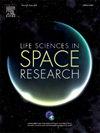Sex-specific effects on the heart from combined exposure to simulated galactic cosmic radiation and hindlimb unloading
IF 2.8
3区 生物学
Q2 ASTRONOMY & ASTROPHYSICS
引用次数: 0
Abstract
Future long duration space missions will expose astronauts to higher doses of galactic cosmic radiation (GCR) than those experienced on the international space station. Recent studies have demonstrated astronauts may be at risk for cardiovascular complications due to increased radiation exposure and fluid shift from microgravity. However, there is a lack of direct evidence on how the cardiovascular system is affected by GCR and microgravity since no astronauts have been exposed to exploratory mission relevant GCR doses. Therefore, we utilized a ground-based mouse model to determine the cardiovascular risks for space radiation exposure while the mice were simultaneously hindlimb suspended to mimic microgravity. 6-month-old male and female C57BL/6 mice were exposed to an absorbed dose of 0 Gy, 0.5 Gy, or 1.5 Gy simulated GCR (GCRsim) that comprised beams of 5 ions at NASA's Space Radiation Laboratory. Subcohorts of mice were hindlimb unloaded (HLU), starting 5 days before GCRsim until the completion of radiation exposure. GCRsim + HLU was performed over 8 hours (0.5 Gy) or 24 hours (1.5 Gy). After completion of GCRsim and HLU, mice were shipped to UAMS for long-term observation. Cardiac function was measured using high resolution ultrasound at 6 and 9 months after exposure. Tissues were collected after the final ultrasound and prepared for further analysis. Female mice exposed to 1.5 Gy + HLU demonstrated a significant increase in body weight compared to ground controls months after GCR exposure; however, there was no change in male body weights. Cardiac ultrasound revealed 0.5 Gy GCRsim decreased left ventricular (LV) mass, LV posterior wall thickness in diastole, and systole in males 6 months after exposure. In females, 1.5 Gy + HLU significantly increased LV posterior wall thickness in diastole and systole at 6 months. These changes in ultrasound measurements were no longer seen at 9 months. Moreover, at 9 months there was no change in total collagen content or density of the capillary network in the heart. Lastly, the combination of GCRsim and HLU influenced immune cell markers in the heart of female mice. These data suggest that combined simulated GCR and microgravity result in minor, yet statistically significant sex-dependent changes to body weight and cardiac structure.
联合暴露于模拟银河宇宙辐射和后肢卸荷对心脏的性别特异性影响。
未来的长时间太空任务将使宇航员接触到比国际空间站更高剂量的银河宇宙辐射(GCR)。最近的研究表明,由于辐射暴露增加和微重力造成的流体流动,宇航员可能面临心血管并发症的风险。然而,由于没有宇航员暴露于与探索任务相关的GCR剂量,因此缺乏关于GCR和微重力如何影响心血管系统的直接证据。因此,我们利用地面小鼠模型来确定空间辐射暴露的心血管风险,同时将小鼠后肢悬吊以模拟微重力。6个月大的雄性和雌性C57BL/6小鼠在美国宇航局的空间辐射实验室中暴露于0 Gy, 0.5 Gy或1.5 Gy的模拟GCR (GCRsim)吸收剂量,该剂量由5个离子组成。小鼠亚群在GCRsim前5天开始后肢卸载(HLU),直到完成辐射暴露。GCRsim + HLU在8小时(0.5 Gy)或24小时(1.5 Gy)内进行。完成GCRsim和HLU后,将小鼠送到UAMS进行长期观察。暴露后6个月和9个月用高分辨率超声测量心功能。在最后的超声检查后收集组织,准备进一步分析。暴露于1.5 Gy + HLU的雌性小鼠在GCR暴露数月后,与地面对照组相比,体重显著增加;然而,男性的体重没有变化。心脏超声显示0.5 Gy GCRsim暴露6个月后,男性左室(LV)体积、左室舒张后壁厚度和收缩期均下降。在女性患者中,1.5 Gy + HLU可显著增加6个月时舒张期和收缩期左室后壁厚度。这些变化在9个月时不再出现在超声测量中。此外,在9个月时,心脏毛细血管网的总胶原含量和密度没有变化。最后,GCRsim和HLU联合使用对雌性小鼠心脏免疫细胞标志物的影响。这些数据表明,结合模拟GCR和微重力会导致体重和心脏结构的轻微但具有统计学意义的性别依赖性变化。
本文章由计算机程序翻译,如有差异,请以英文原文为准。
求助全文
约1分钟内获得全文
求助全文
来源期刊

Life Sciences in Space Research
Agricultural and Biological Sciences-Agricultural and Biological Sciences (miscellaneous)
CiteScore
5.30
自引率
8.00%
发文量
69
期刊介绍:
Life Sciences in Space Research publishes high quality original research and review articles in areas previously covered by the Life Sciences section of COSPAR''s other society journal Advances in Space Research.
Life Sciences in Space Research features an editorial team of top scientists in the space radiation field and guarantees a fast turnaround time from submission to editorial decision.
 求助内容:
求助内容: 应助结果提醒方式:
应助结果提醒方式:


